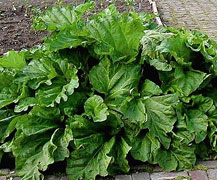


Home
Flowers &
Indoor Plants
Fruits & Nuts
Ornamentals
Vegetables
Special Topics
Resources
Glossary

|
Rhubarb Rheum rhabarbarum (Ree-um-rah-bar-bar-um) 


 Click on thumbnails for larger image. |
 |
What about it? Rhubarb is a spring-harvested perennial that ranges in color from green to bright red. Traditionally it played a significant role in the American diet. A rhubarb plant can stay in production for over a decade. It is a member of the Buckwheat family and therefore related to sorrel and dock. What is it used for? The leaf stalls, also called the petiole, is the edible portion. It has a rich but tart flavor. Some folks like to eat it raw where others mix it with some type of sweetener and make rhubarb pie. Where does it grow? How do we grow it? Rhubarb is a cool weather crop. It also prefers a fertile and well-drained site because it is a heavy feeder. Since it is a perennial it is important to consider the long-range potential of the planting site. Put it somewhere that it won't be disturbed for 5 to 10 years. Rhubarb is grown from sections of roots and not seeds. Space these pieces 4 feet apart. What are its primary problems? Crown rot is a potential disease.How do we harvest and store it? If the plants seem healthy you can consider harvesting them the first spring after planting. Harvest the stalks between 8 and 12 inches long, very early in the spring. Pull up on the stalk of the plant to separate it, don't cut it. Trim away the leaves - these contain irritants and should not be eaten. No parts of the plant should be harvested after early spring. Store the stalks in a humid area.
© Copyright, Department of Horticulture, Cornell University. |